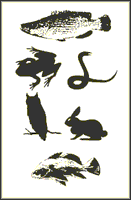Nebraska Cooperative Fish & Wildlife Research Unit
Date of this Version
2013
Citation
Allen, C. R., K.T. Nemec, D. A. Wardwell, J. Hoffman, M. Brust, K. Decker, D. Fogel, J. Hogue, A. Lotz, T. Miller, M. Pummil, L. E. Ramirez-Yanez, and D. Uden. 2013. Predictors of regional establishment success and spread of introduced non-indigenous vertebrates. Global Ecology and Biogeography 22:889-899.
Abstract
Aim To provide the first analysis of predictors of both establishment and spread, both within and across taxa, for all vertebrate taxa within a region.We used Florida, USA, as our study system because it has a well-documented history of introduction and invasion, and is a hotspot for biological invasions.
Location Florida, USA.
Methods We analysed non-indigenous species (NIS) data from peninsular Florida – which included both successful and unsuccessful introductions from all vertebrate classes – to determine the best predictors of both establishment and spread for fish (65 species), herpetofauna (63 species), birds (71 species) and mammals (25 species). We used 10 variables proposed to be associated with the establishment and spread of NIS: body mass, geographic origin, reproductive rate, diet generalism, native-range size, latitude of native range, number of NIS present at date of introduction, presence of NIS congeners, morphological proximity to other NIS (in terms of body mass) and propagule pressure. A multimodel selection process was used with an information-theoretic approach to determine the best fit models for predicting establishment and spread of NIS.We selected a priori plausible predictive models for establishment and spread.
Results Large native-range size and small body mass best predicted establishment of non-indigenous herpetofauna. The presence of NIS congeners had the largest positive effect on the establishment of non-indigenous fish. For mammals, the number of NIS present at the time of introduction best explained establishment. No single model best explained bird establishment. For all taxa but birds, the number of NIS present at time of introduction was included in at least one of the best-supported models for explaining spread.
Main conclusions Our analyses suggest that predictors of establishment and spread differ across vertebrate taxa at the scale studied. Most predictive variables can be interpreted as measures of competitive interactions among species.
Included in
Aquaculture and Fisheries Commons, Environmental Indicators and Impact Assessment Commons, Environmental Monitoring Commons, Natural Resource Economics Commons, Natural Resources and Conservation Commons, Water Resource Management Commons


Comments
US government work.